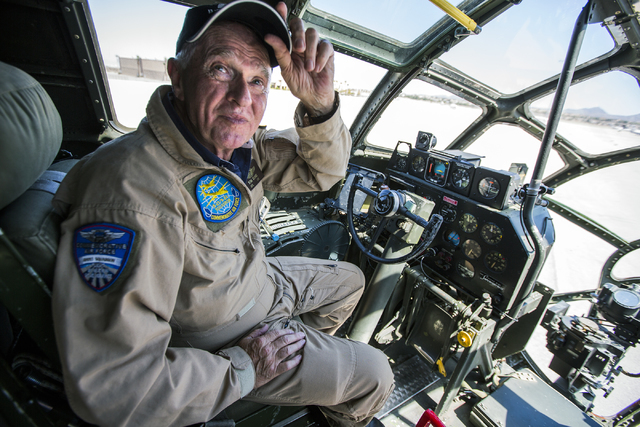WWII planes fly in to Henderson as part of traveling museum tour

Tom Travis negotiated a narrow ladder and eased his frame into the cockpit of a B-29 Superfortress bomber Monday afternoon at the Henderson Executive Airport.
“This plane was built for freedom, not for comfort,” he said of the B-29 airplane that dropped nuclear bombs on Hiroshima and Nagasaki, effectively ending World War II.
The B-29 arrived at the Henderson Executive Airport on Monday and will be available from Wednesday through Sunday for the public to tour, and possibly ride. The airport is hosting World War II fighter planes as part of the third Commemorative Air Force Airpower History tour, which is stopping by Nevada for the third consecutive year.
“It’s a flying circus,” said Al Herum, a co-pilot of the B-29, of the “living history flight experience” tour.
“At most museums you see static displays: nothing moving, can’t touch it, can’t hear it, can’t smell it. You can only see it from a distance. What we have is (a traveling museum with) operational equipment that flies and that takes people on rides.”
The “flying circus” consists of the B-29, which is one of just two in flyable condition in the world, a T-6/SNJ Texan and a C-45 Expeditor.
The B-29 bomber was developed to replace the older B-17s and B-24s, because fighter pilots needed a bomber with a longer flight range and one that could carry a heavier bomb load.
The B-29 also represented state-of-the-art technology in its time.
“It was the first pressurized (U.S.) bomber,” Herum said. “In the B-17 pilots wore electrically heated suits with that (about 5-inches) thick of padding on them, and they still froze. The B-29 has two pressurized compartments, forward and aft, connected by a tunnel, so the guys could sit in there with short sleeves, because they could control the environment, both hot and cold and the pressurization, so they didn’t wear oxygen masks.”
The B-29 was also the first bomber with a computerized gun system. It was in active service between 1944 and the late 1950s.
The T-6 was a training aircraft for Allied fighter pilots.
“It’s a little squirrelly on ground handling, so if you could fly a T-6 you could pretty much fly anything else,” Herum said.
The C-45 Expeditor was a transport aircraft.
“There are some civilian versions of the C-45 that still fly cargo and freight today,” he said.
Admission is $10 for adults and $5 for children ages 11-17; kids under 10 are free. Rides also can be purchased in any of the planes for prices ranging from $75 to $1,595.
Although there is certainly entertainment value in the “flying circus,” the tour can be a very emotional experience, as it pays tribute to the men and women who served during World War II, organizers said.
“We want to remember what they did in service. Not just veterans who were in the service, but also Rosie the Riveters, people who built the airplanes and did all of the associated things that go around these airplanes to keep them flying,” Herum said.
Travis said it is often an emotional experience for him as well. His father was killed in service two weeks before the war ended in 1945.
“We’re trying to teach history, so the young people won’t have to do this all over again.”
Contact Nicole Raz at nraz@reviewjournal.com or 702-380-4512. Follow @JournalistNikki on Twitter.